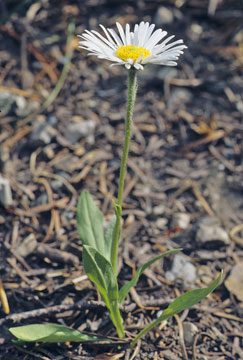 |
Evermann's Fleabane, Erigeron
evermannii Rydbg. (left)
is a one-flowered composite characterized by a bare, furry stem and lanceolate
basal leaves. It is a true mountain plant, found only in Idaho, Montana
(where it is rare), and Alberta. Its rays may be tinged with blue or pink,
although ours are usually white as shown here. Barton Warren
Evermann (1853-1932) was a naturalist, best known as an ichthyologist
and author of Fishes of North and Middle America
(1900).
Coulter’s daisy, Erigeron coulteri
Porter (right). Coulter’s daisy is another one-flowered composite.
It is a much taller plant, than Evermann's fleabane, and its stems are not
bare but have several to many lanceolate leaves that become stemless as they
ascend. There also tend to be more rayflowers—Coulter’s daisy
usually has 40 to 100 rays, whereas Evermann’s daisy usually has 40
or fewer. Coulter’s daisy grows at higher altitudes, often along streams,
and is present in all of the Rocky Mountain States, and in Nevada and California.
John Merle Coulter, (1851-1928), for whom the plant is named started his
career as botanist to a geological expedition that explored the Rocky Mountains
in 1872-73. He later became an academic, holding chairs in botany at several
colleges.
|
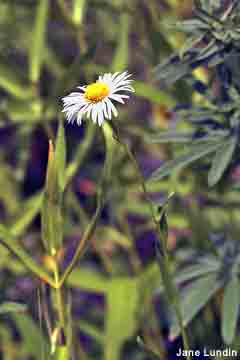 |
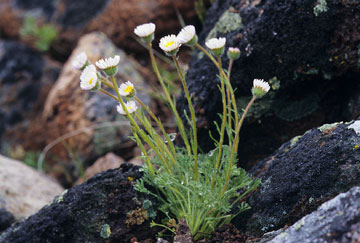 |
The Dwarf mountain (or Cutleaf) Fleabane,
Erigeron compositus Pursh (left)
is a miniature daisy found at mid– to alpine elevations. Clumps, like
the one illustrated on the right, bloom in mid- to late spring, usually on
exposed rocky ridges. The specific name, compositus means
“compound” or “made up” referring to its three-parted,
or “ternate,” leaves, each made up of three leaflets. Lewis and
Clark were the first to collect the cutleaf daisy . There is some debate
as to whether their specimen was gathered while outward bound in the fall
of 1805, or on their return journey in the spring of 1806 while on the Clearwater
River in Northern Idaho. This little plant can be an attractive addition
in a rock garden.
White prairie aster, Symphyotrichum falcatum
(Lindl.) G. L. Nesom (right). The white prairie
aster is distinguished by clusters of white flowerheads that tend to be borne
on the same side of tall stems. The plants spread by short rhizomes which
also contributes to their clustered appearance. Although commonly found on
the plains, the plants also grow in our mountains. This one was photographed
just west of Lolo Pass in north central Idaho. The name, falcatum,
means “sickle-shaped.” It is not clear why it was applied to this
plant. |
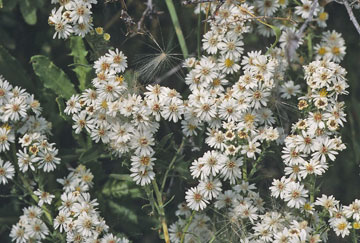 |
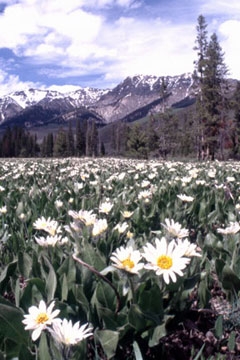 |
White Mules-ears, Wyethia
helianthoides
Nutt. Nathaniel Wyeth (1802-1856)
discovered this plant in Idaho in 1833, and it was named for him the following
year by botanist Thomas Nuttall. The species name means "sunflower-like."
Look at the flower disk, and you'll see that it is made up of a myriad
of tiny tubular flowerlets. Other tiny flowers along the margin bear the
rays, explaining the older family name "Compositae," The common name "mules-ears"
refers to the plant's large leaves. Spring-blooming white wyethias are found
along seasonal streams and in moist meadows, often in great profusion
as seen on the left. The plant is found only in Idaho and contiguous states.
Interestingly, when the white Wyethia helianthoides and the
yellow-flowered Wyethia amplexicaulis (shown on the next page)
grow side-by-side they may hybridize as a pale yellow-flowered form that
has been given the scientific name Wyethia x
cusickii Piper (right). |
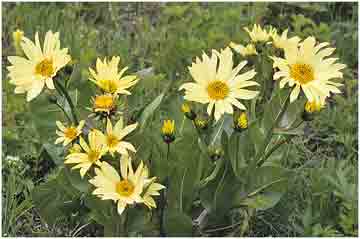 |





